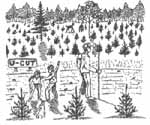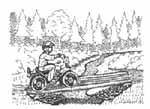Module 9: Woodlot Recreation
Lesson One - Introduction to Outdoor Recreation
This lesson gives you an understanding of outdoor recreation and its benefits. It also explores integrating recreation with other uses or values on your woodlot.
WHAT IS OUTDOOR RECREATION?
According to a 1993-94 Nova Scotia Woodlot Owner Survey conducted for the Nova Scotia Department of Natural Resources, 27 per cent of respondents said outdoor recreation was one of the reasons they own their woodlot. Outdoor recreation refers to leisure activities that take place in a natural setting and benefit the body, mind and/or spirit. Examples are hiking, fishing, skiing, snowmobiling and wildlife viewing.
Outdoor recreation can overlap with competitive outdoor activities such as orienteering or ski races. It can also be done with other activities such as environmental education for example hiking to study an old growth forest. Outdoor recreation can also simply be enjoying the peace and quiet in a non-physical way.
Table 1 illustrates the wide variety of outdoor recreation activities and may give you a few new ideas too. Some of the more common ones are listed below. Check off those you do now on your woodlot and put a question mark beside those you are considering.
|
|
Hiking |
|
Cross country skiing |
|
|
Running |
|
Skating |
|
|
Mountain biking |
|
Snowshoeing |
|
|
Horse riding |
|
Snowmobiling |
|
|
Canoeing |
|
ATV/ dirt bike riding |
|
|
Camping |
|
Wildlife viewing |
|
|
Rock climbing |
|
Nature study |
|
|
Swimming |
|
Photography |
|
|
Fishing |
|
Hunting |
|
|
Other: | ||
WHAT ARE THE BENEFITS?
Outdoor recreational activities benefit people in a variety of ways. Some are listed below. Many activities provide a combination of physical, mental and spiritual benefits.
Physical fitness
Some of these activities will help keep you physically fit if you do them regularly.
Relaxation
The woodlot provides a quiet setting to escape from everyday pressures and relax your mind while enjoying an outdoor activity.
Adventure
Some of these activities such as mountain biking can be stimulating, challenge your limits, and provide fun and adventure.
Personal enjoyment
You may appreciate the outdoors for such pleasures as enjoying the beautiful scenery, or the sense of discovery in finding interesting historical or natural features such as wild flowers.
Nature Appreciation
Spending time on the woodlot can encourage an appreciation of what we see and a desire to better understand and care for nature.
Other
If outdoor recreation benefits you in another way, describe it here in a sentence or two.
Give each benefit listed a rating of 1, 2 or 3 depending on how important it is to you. One is Very Important, Two is Somewhat Important and Three is Not Very Important. Write the number beside the benefit.
Table 1. List of outdoor recreation activities
| Type | Land Based Activities | Water Based Activities | Air/ Underground |
| Non - Consumptive |
Camping - Family Camping - Group Camping - Backcountry Trails - Nature Trails - Hiking Trails - Cross Country Adventure Rope Courses Rock Climbing Nature Study-Bird Watching Nature Study-Mushrooms Nature Study-General Nature Photography Landscape & Nature Painting Archery Paintball Games Wide Games Adopt-a-Forest Biodiversity Plots Cross Country Skiing Running Orienteering |
Ice Skating - Lakes Ice Skating - Ponds Ice Skating - Wetlands Wind Surfing Adopt-a-Stream River Rafting Swimming Holes Catch & Release Fishing Canoeing Kayaking |
Caving (Spelunking) Kite Flying Astronomy Hang Gliding |
| Consumptive |
Butterfly Collecting Berry Picking Blackpowder Hunting Lapidary Guiding - Hunting Shooting Range Clay Pigeon Shooting U-Pick Christmas Trees Maple Sugar Production Edible Wilds Forest Pharmacy |
T-Trout Fish Clam Digging Fly Fishing Workshops Gold Panning Guiding - Fishing Ice Fishing |
|
| Motor/ Animal Propelled |
Horseback Trail Riding Sleigh Rides Hay Rides Motor Cycling Snowmobiling Four Wheel Drive Club Motor Cross Dog Trials Fox Scent Hunts ATV Trails |
Water-Skiing Motor Boating |
|
| Indoor/ Outdoor |
Cabin Rentals Campfire Programs Woodlot Management Workshops Barbecues |
Bed & Breakfast Outdoor Cooking Day Camping Hunter Safety |
Fly Tying Workshops Environmental Education Hunter Safety |
INTEGRATION WITH OTHER VALUES
Outdoor recreation is one of many reasons we value our woodlots. If you have a management plan, you've already spent some time considering what values are most important to you. Woodlot values can include:
|
|
Recreation |
|
|
Wildlife habitat |
|
|
Wood production (pulp, sawlogs, Christmas trees) |
|
|
Aesthetics (how your woodlot looks) |
|
|
Biodiversity (a healthy, functioning mix of species) |
|
|
Soil and water conservation |
|
|
Improving for future generations |
|
|
Other: |
Give each value listed a rating of 1, 2 or 3 depending on how important it is to you. One is Very Important, Two is Somewhat Important and Three is Not Very Important. Write the number beside the value. Note to yourself if your values have changed from when you first did your management plan and why?
 |
|
Illustration #1: Outdoor recreation comes in many forms |
Integrated resource management
It is possible to manage your woodlot for several values at the same time. This is known as integrated resource management (IRM). The goal of IRM is sustainable use for a variety of values which means meeting the needs of today without reducing the land's ability to meet the needs of future generations. To ensure sustainable use of our woodland, it must have the potential to be managed for all the values listed above.
 |
|
Illustration #2: Hiking in a Christmas tree plantation. |
The following examples look at specific integration problems.
Example One
Riding your All Terrain Vehicle (recreation value) and preserving fish habitat (wildlife value) are both important to you. Some time ago, you read the Woodlots and Wildlife module, and recall that riding vehicles through streams is very destructive to fish habitat. But one of your favourite ATV routes goes through a stream. Are both possible? You look at alternate routes and also research bridge designs and cost. After some thought, you decide it's worth your time and effort to build a bridge to sustain both values.
 |
|
Illustration #3: Bridges protect fish habitat from ATV's. |
Example Two
You enjoy bird watching as a recreational activity and you also want to encourage breeding pairs. One of your favourite walks is close to an eagle's nest where you watch the eaglets in spring and early summer. However, the Wildlife and Forestry module says that between March and July "unusual activity can cause nest failure". Can you accommodate both values? After a visit to the area, you decide to cut out a new trail in the fall. You know that cutting is not recommended within I00 metres (328 feet) of a nest. The trail will not be close to the nest but you plan it so you will have a good view using binoculars when the birds are nesting.
Integrating woodlot values involves these three questions:
- What do you want on your woodlot?
- What is possible?
- How can you make it happen?
This and other module explores each of the above questions to help you develop an overall recreation plan for your property. Lesson Two looks at the first question as it deals with assessing your recreation goals. Lesson Three looks at what sort of recreation is possible on different parts of your woodlot. Lesson Four provides practical information on how to build or improve trails and various structures. After a brief look at legal issues in Lesson Five, all this information will be pulled together to help you design your action plan in Lesson Six
Still, there is no single formula for every situation for integrating recreation with other values. Each woodlot and woodlot owner are different. You may first need to learn more about some of these values by reading or talking to people knowledgeable in these areas. Woodlots and Wildlife module has much relevant information as well as the module on Woodlot Ecology. Other useful references are listed at the end of this module. Some tradeoffs may look at how the forest community uses these components of the forest site.
